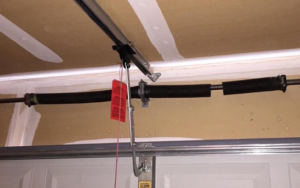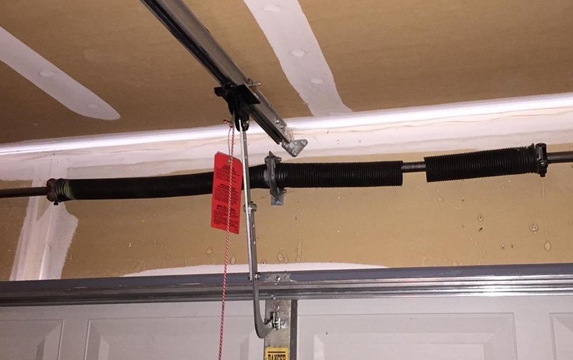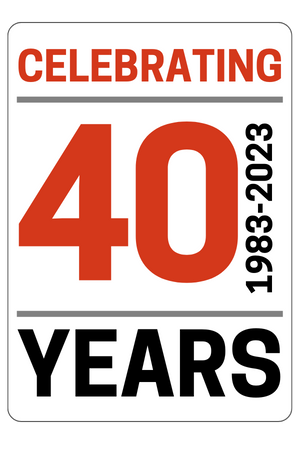 Among the relatively small selection of garage door parts to be considered for routine maintenance or replacement, garage door torsion springs are the most dangerous. Statistics show more than 30,000 people are injured by garage doors every year. People die in these accidents. Possibly the most serious threat comes from underestimating the power and potential of garage door torsion springs.
Among the relatively small selection of garage door parts to be considered for routine maintenance or replacement, garage door torsion springs are the most dangerous. Statistics show more than 30,000 people are injured by garage doors every year. People die in these accidents. Possibly the most serious threat comes from underestimating the power and potential of garage door torsion springs.
Garage door torsion springs are tightly-wound, high-tension steel. They wear out and break. When a spring breaks it can lash out and strike whatever’s near – people or property. Unlike other garage door parts that may have recommended replacement schedules, a garage door spring’s life is determined by the number of times it raises and lowers the heavy door. Will a spring last five years? Ten years? Obviously, the older it is the more likely it will fail, but not just from age – from repeated use.
Professional Inspection A Timely Course of Action
If you have older, actively used garage doors regular inspections by a trained professional is a wise investment. Spotting weak spots before garage door torsion springs break provides for timely replacement – there’s never a good time for your garage door to stop moving so prevention is crucial.
TIPS FROM THE PROS — If your garage door has two torsion springs, when one breaks, replace them both. Both springs are subjected to the same open/close cycles so when one fails the other is a candidate for failure very soon.
Consider that your garage door is the largest, heaviest moving part in your home. It can weigh more than 400 pounds and it hangs above your head. Not taking the routine care of this simple, yet serious piece of technology puts you, your family and possessions at risk.
Temperature Affects Garage Door Torsion Springs’ Performance
While cold temperatures of a Madison WI winter don’t impact objects like they do humans, metal parts do not respond as well when it’s cold. Metal can become more brittle and react slower in the cold. All the garage door parts are susceptible to this reaction, but coiled steel springs already weakened by age and stress present more of a problem as the season changes.
Here are tips for keeping your garage door in top shape all year:
- Be alert to changes – If your garage door is squeaking, rattling or “groaning” it could be telling you something. Does it open and close as smoothly as it should – is it jerky or does it seem to fall the last few inches? Being aware of change is your first step to heading off a serious situation in the future.
- Inspect regularly – Routinely go over all your garage door parts for wear or damage.
- Keep up with all routine maintenance and lubrication – there are some things you can and should do (plus others you should leave to the pros!)
TIP FROM THE PROS — Do Not Use WD-40 on your garage door torsion springs! WD-40 has specific uses and properties but lubrication is not one of them. Use a lubrication product specifically recommended for garage door springs.
- Follow manufacturer’s recommendations, requirements – Owners’ manuals are designed to keep you safe and your garage door working smoothly. When questions come up, contact a trained professional.
- Do Not Try This On Your Own! – No matter how accomplished you think you are as a do-it-yourselfer, changing garage door torsion springs is one project best left alone. First, making sure the job is done right is a primary concern and it takes training, experience and job-specific tools. Garage door torsion springs, even broken, are under extreme pressures. Pressures that can be released with disastrous consequences in a fraction of a second.
TIP FROM THE PROS — If the wrong tool (people have used everything from pipe wrenches to tire irons) is applied in the wrong position when the pressure releases, that tool can be launched like a missile. Anything in its path is in for a violent shock – bones have been broken, walls have been penetrated and people have been killed.
- Replace Springs When It’s Time – Make notes if you see signs of wear of weakness and get your garage door installation professional in for a review as soon as possible. The life of the garage door torsion springs depends upon how often you use the door. Since today’s architecture and lifestyles make the garage door the primary point of entry for more and more people, owners don’t think their garage door parts are lasting as long as they used to.
RULE OF THUMB — A common garage door spring should have a lifespan of about 10,000 up/down cycles. That should be from five to seven years. Heavy duty springs could expand that to 50,000 cycles or more. In today’s homes with multiple garage doors, the life of one may be longer than another just because one door gets most of the traffic. It makes sense to inspect garage door torsion springs more closely once they’ve hit their fifth year on the job.
The trained professionals at Northland Door Systems can provide timely service, repair and installation of all garage door parts, including garage door torsion springs. You benefit from the area’s widest selection of manufacturers and in-stock supplies making sure your get the right garage door springs and parts for your needs.
Call Northland Door Systems at 608-251-3627 or email us for professional assistance with garage door maintenance, opener installation and repair and a huge selection of garage door parts and garage door torsion springs in Madison WI.
Only one of these garage door torsion springs broke, but it’s a wise move to replace them both at the same time – the second one is the same age and is just another service call waiting to happen!












